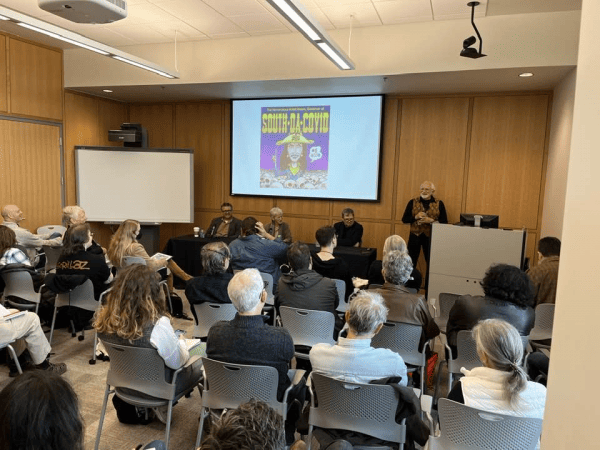CSotD: CXC Opening Day
Skip to comments
The first day of the AAEC Conference began with a long business meeting and ended, alas, with the discovery that my camera had been lying to me all day long. So it goes.
But backlighting and shadows are appropriate here because they probably shouldn’t have even let a non-voting associate in, and, like most such meetings, it was a lot of unreportable, not-all-that-fascinating-to-anyone-else insider information about current status and future possible plans and changes in by-laws.
And donuts and coffee from Tim Horton’s, which made up for the fact that the 2020 conference in Ottawa was cancelled due to the pandemic.
It was a lively discussion with, as might be expected, a fair amount of wisecracks and laughter amid the serious matter.
One item that did come up and that I feel free to report on was a discussion of how many editorial cartoonists are not members, and, if you are one of those people, you may be hearing that from your colleagues in the near future and you should consider joining.

The preponderance of attendees seem to be from the left side of the aisle, and, while the issue of political standing was noted with regret at that business meeting, with memories of a once more politically diverse membership, it came up again at an afternoon session, “Do Awards Still Matter?” which featured Lalo Alcaraz, Signe Wilkinson and Clay Jones, with Kal Kallaugher moderating. (Photo by Paul Berge)
It emerged in large part because the Pulitzer Committee ended the Editorial Cartooning prize abruptly in 2021, overruling the judges’ recommendations of Alcaraz, Ruben Bolling and Marty Two Bulls and awarding no prize at all, then shifting to the “Pulitzer Prize for Illustrated Reporting and Commentary” for a NYTimes illustrated report on the Uyghurs, rather than opinion pieces that, over a century, had spanned both sides of the political spectrum.
This drew the observation that, with the Pulitzers gone, several of the surviving awards — particularly, the RFK — are specifically intended to reward humanitarian work, which is by definition liberal. Others, like the National Headliner award, are less specific in what they’re looking for.
What made the discussion more complete and compelling than the usual panel talk was the number of people both on the panel and in the audience who have served as judges and could discuss the issue of putting aside politics and personal friendships to judge submitted portfolios on their own merits.
That’s a key element of journalism, but one more commonly ascribed to reporters than to opinionators, though it applies there as well.
And, BTW, in another message to cartoonists reading this, there have been fewer entrants for a variety of awards in recent years and your odds are better than ever.
I say this as someone who, as a reporter, didn’t take awards seriously but liked winning them because it raised my profile with management, and who, as an editor, despised awards because of the work involved in gathering, formatting and submitting portfolios.
I would also note that several national awards — which often include a cash prize — require an entry fee, which publishers once happily picked up. I suspect many of them have, in recent years, put that employee benefit aside along with the free coffee in the breakroom.
Leaving an open field for those willing to make the effort and risk the fees.

Later that afternoon, CXC presented a defiantly progressive pair, Wimmin’s Comix creators Lee Marrs and Trina Robbins, with memories of the days when they broke through the boys’ club and began producing and anthologizing comics for women.
That small group of women cartoonists “was the first tribe I belonged to,” Marrs said, adding that, when they began in the early 70s, they found that Europe already had both a lively element of telling personal stores in comics as well as a healthy respect for women’s voices.
By contrast in this country, Robbins said, when she announced that she was writing a history of women’s comics, the standard response was “That’ll be a slim volume,” but she has since produced five such histories, plus doing other work in the genre, an carving out a distinguished career in the overall industry.
Which has neither dulled her wit nor caused her to forgive and forget.
The existence of women cartoonists did not guarantee the success of women’s comics, and they told of times a printer would refuse to produce their “pornography,” adding that one such squeamish printer had refused their work as pornographic but printed a male comic of no less salacious work on the grounds that it was “satire.”
Their stories raised more laughter than horrified gasps, but it was dark humor, and they both expressed bitterness over the comic book shops that mirror the fictional one in the Simpsons, a business that limits its stock to superhero stories and that actively, openly courts and caters to an-all male audience.
“If they ordered, they ordered one or two copies,” Marrs recalled. “And when those sold, they didn’t reorder. They’d say ‘Women don’t read comics.'”
Robbins acknowledged that self-fulfilling prophecy for the stores themselves, but added that she and Marrs received a lot of notes over the years from fans saying, “I love your comics but I can never find them.”
Asked if they had any further thoughts on the process they’d gone through, Robbins said, “I think we did a pretty good job!”
To which Marrs sardonically responded, “I wish we’d gotten paid.”

The happy ending being a long line of fans with books to be signed.
Back tomorrow.
Comments
Comments are closed.